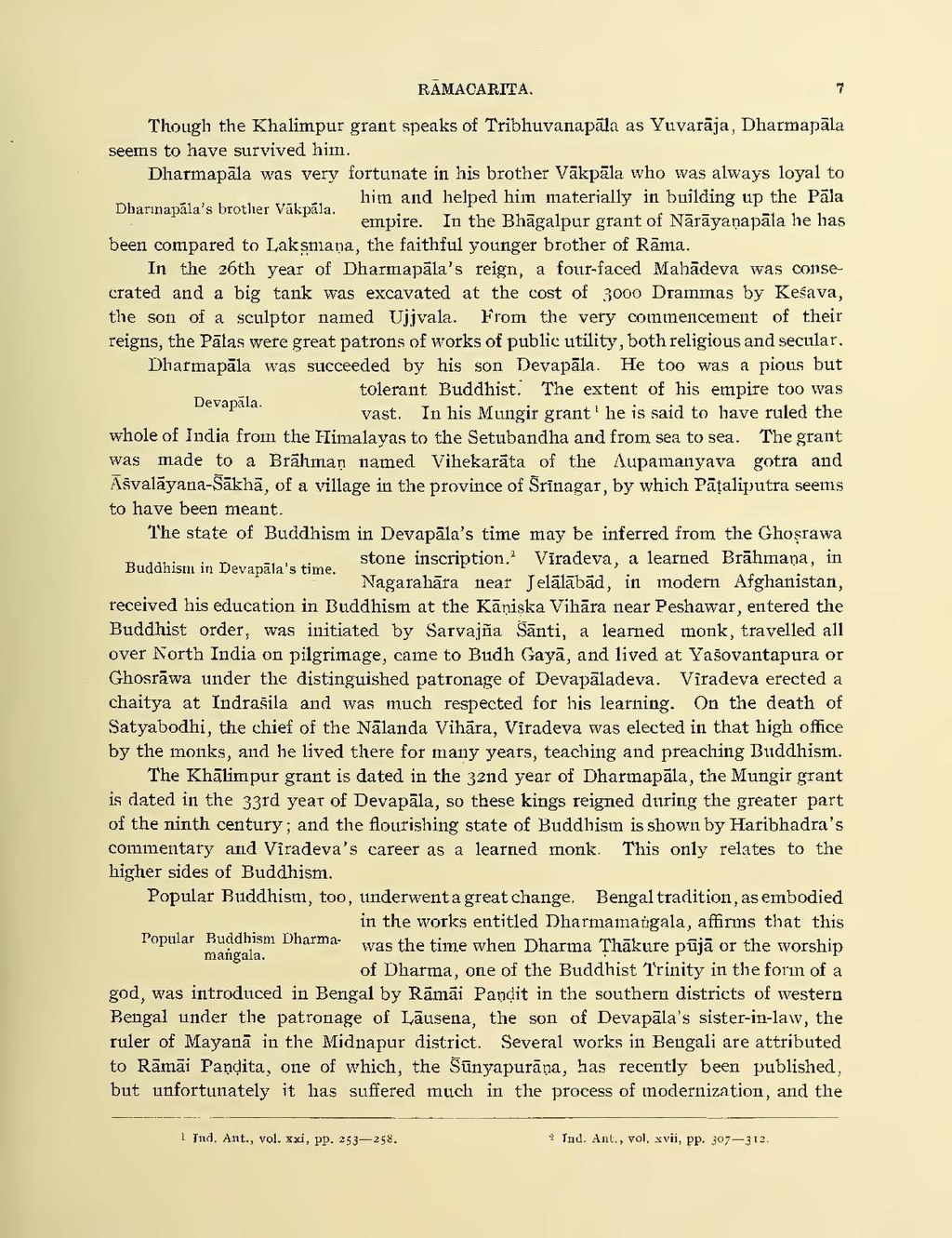RAMACARITA. Though the Khalimpur grant speaks of Tribhuvanapāla as Yuvarāja, Dharmapāla seems to have survived him. Dharmapala was very fortunate in his brother Vakpala who was always loyal to him and helped him materially in building up the Pala empire. In the Bhagalpur grant of Nārāyaṇapāla he has been compared to Laksmana, the faithful younger brother of Rama. Dharinapala's brother Vākpāla. In the 26th year of Dharmapala's reign, a four-faced Mahadeva was conse crated and a big tank was excavated at the cost of 3000 Drammas by Keśava, the son of a sculptor named Ujjvala. From the very commencement of their reigns, the Palas were great patrons of works of public utility, both religious and secular. Dharmapala was succeeded by his son Devapāla. He too was a pious but tolerant Buddhist. The extent of his empire too was Devapāla. vast. In his Mungir grant he is said to have ruled the whole of India from the Himalayas to the Setubandha and from sea to sea. The grant was made to a Brahman named Vihekarata of the Aupamanyava gotra and Ašvalāyana-Sākhã, of a village in the province of Srīnagar, by which Pāṭaliputra seems to have been meant. 7 The state of Buddhism in Devapala's time may be inferred from the Ghoşrawa stone inscription. Viradeva, a learned Brāhmaṇa, in Buddhism in Devapāla's time. Nagarahāra near Jeläläbäd, in modern Afghanistan, received his education in Buddhism at the Kāṇiska Vihāra near Peshawar, entered the Buddhist order, was initiated by Sarvajña Santi, a learned monk, travelled all over North India on pilgrimage, came to Budh Gaya, and lived at Yašovantapura or Ghosrāwa under the distinguished patronage of Devapaladeva. Viradeva erected a chaitya at Indrašila and was much respected for his learning. On the death of Satyabodhi, the chief of the Nalanda Vihara, Viradeva was elected in that high office by the monks, and he lived there for many years, teaching and preaching Buddhism. The Khalimpur grant is dated in the 32nd year of Dharmapala, the Mungir grant is dated in the 33rd year of Devapāla, so these kings reigned during the greater part of the ninth century; and the flourishing state of Buddhism is shown by Haribhadra's commentary and Viradeva's career as a learned monk. This only relates to the higher sides of Buddhism. Popular Buddhism, too, underwent a great change. Bengal tradition, as embodied in the works entitled Dharmamangala, affirms that this was the time when Dharma Thakure pūjā or the worship of Dharma, one of the Buddhist Trinity in the form of a god, was introduced in Bengal by Ramãi Pandit in the southern districts of western Bengal under the patronage of Lausena, the son of Devapala's sister-in-law, the ruler of Mayana in the Midnapur district. Several works in Bengali are attributed to Rāmai Pandita, one of which, the Šūnyapurāṇa, has recently been published, but unfortunately it has suffered much in the process of modernization, and the Popular Buddhism Dharma- mangala. 1 Ind. Ant., vol. xxi, pp. 253-258. 2 Ind. Ant., vol, xvii, pp. 307-312.

